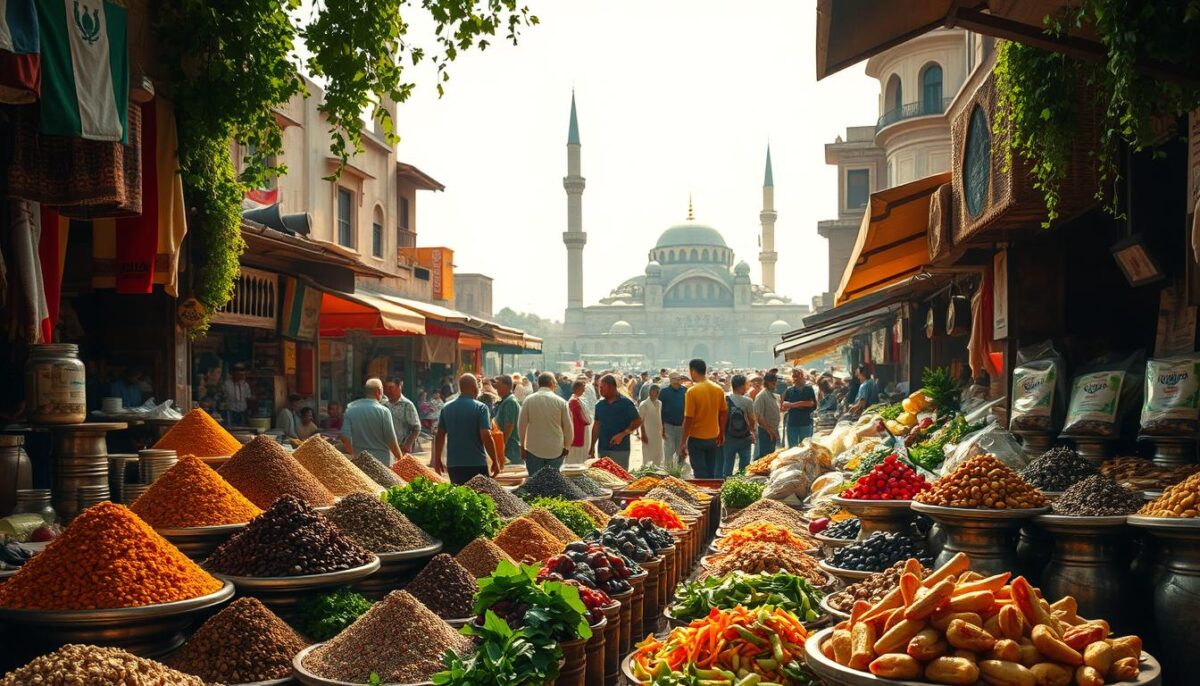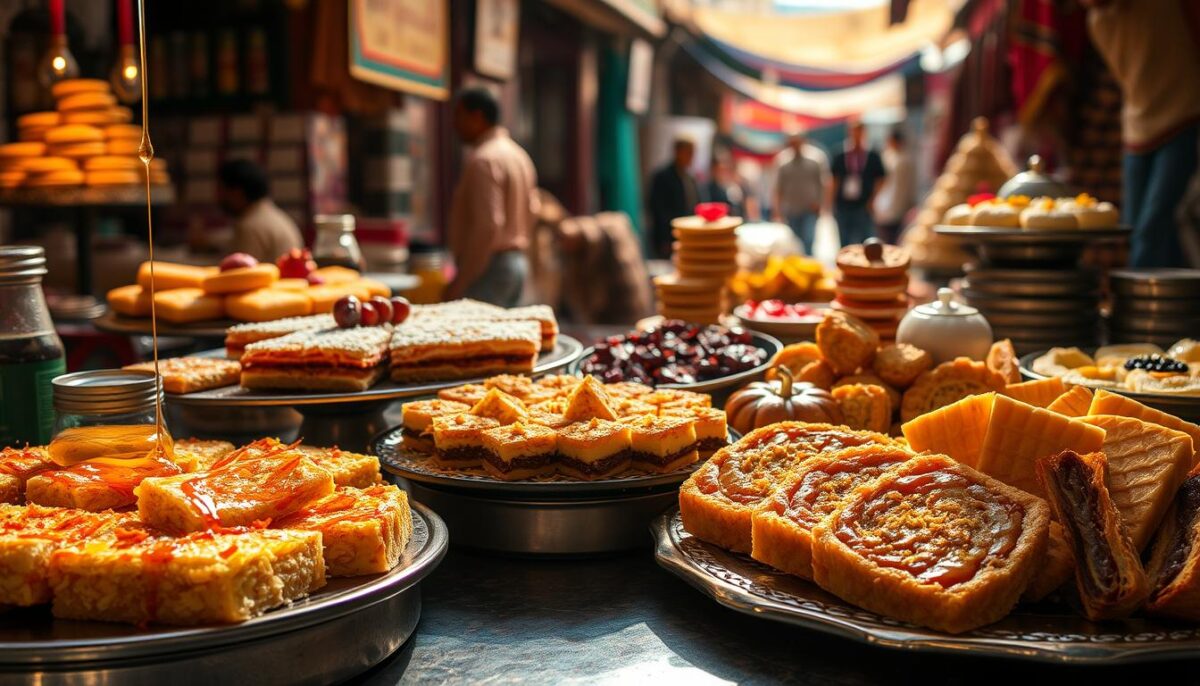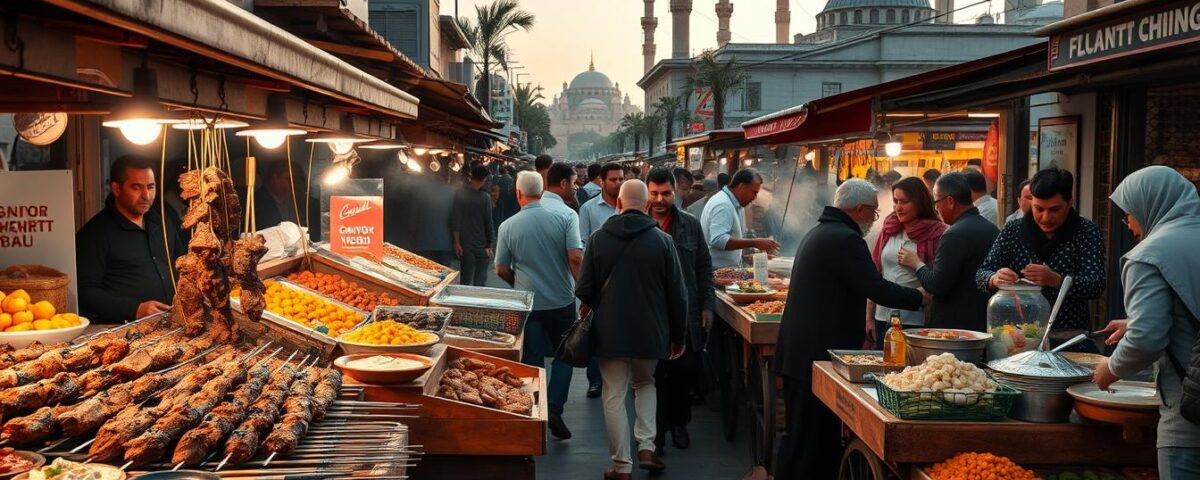
5 Local Treats You Shouldn’t Miss in Rio de Janeiro
June 11, 2025
The Must-Eat Meals in Toronto Every Foodie Should Know
June 12, 2025Did you know that over 80% of Egypt’s most iconic dishes use ingredients cultivated along the Nile for millennia? Standing in a bustling Cairo market last summer, I watched a vendor stuff fresh molokhia leaves into paper cones. “This is how pharaohs ate,” he grinned. In that moment, I realized how deeply food here ties to history—and how hungry I was to explore it.
My journey began with a simple koshary bowl. Chickpeas, lentils, and crispy onions piled atop tangy tomato sauce. Each bite felt like unraveling layers of time. Local cooks still rely on staples like dates, garlic, and cumin—ingredients painted on ancient tomb walls. But modern twists surprise, too. A chef once handed me fig-glazed duck, whispering, “Cleopatra’s favorite flavors, reimagined.”
What excites me most? Discovering how meals here aren’t just sustenance. They’re living stories. From street carts to upscale restaurants, every dish bridges past and present. I’ve tasted flatbreads baked in ovens unchanged for centuries, then sipped hibiscus cocktails at rooftop bars overlooking the pyramids. This isn’t just eating—it’s time travel.
Key Takeaways
- Nile Valley ingredients like legumes and herbs form the backbone of traditional meals
- Ancient recipes often appear in modern dishes with creative updates
- Dining here offers direct connections to 5,000 years of cultural history
- Street food and fine dining both reveal unique aspects of local identity
- Seasonal produce dictates menu changes, keeping flavors vibrant
Cairo egyptian culinary roots: Tracing History Through Food
Imagine biting into a dish that hasn’t changed its core ingredients in 5,000 years. That’s the magic of eating here—every meal whispers stories of empires and everyday life along the Nile. I once watched a baker slap dough onto a clay oven wall, the same method depicted in hieroglyphs. “Our ancestors knew good bread,” he said, handing me a steaming round. In that moment, I tasted time itself.
Ancient Blueprints on Modern Plates
Local kitchens still rely on legumes, garlic, and herbs like dill—staples found in pharaonic tomb carvings. A chef friend showed me his family’s ful medames recipe, nearly identical to texts from the Middle Kingdom. But foreign influences reshaped traditions too. Ottoman spices like allspice crept into stews, while Greek traders introduced olive oil techniques still used today.
Bridging Millennia in One Bite
Last week, I tried duck seasoned with thyme and fenugreek at a trendy bistro. The owner grinned: “Same flavors Queen Hatshepsut’s chefs used—just better presentation.” What fascinates me isn’t just the survival of recipes, but their reinvention. Street vendors now add chili to ancient fava bean dips, proving traditions evolve without losing their soul.
Three reasons these traditional methods endure:
- Nile Valley soil yields unique herb flavors
- Communal eating preserves recipe continuity
- Modern chefs honor heritage while experimenting
Exploring Traditional Egyptian Dishes & Signature Flavors
My first taste of dawn in the city came with a steaming clay bowl of ful medames. A vendor stirred the fava beans slowly, just as his grandfather taught him. “The secret,” he winked, “is cooking them until they hug the garlic like old friends.”
Must-Try Classics That Define a Culture
That earthy ful medames taught me how simple ingredients become magic. Across town, I discovered molokhia‘s velvety leaves swimming in garlicky broth—a texture like green silk. Locals call it “the dish that sticks to your ribs and your memories.”
Then came the koshari revelation. A street cook layered lentils, rice, and crispy onions with precision. “Every grain tells a story,” she said, drizzling tangy tomato sauce over the pyramid. History never tasted so satisfying.
Flavor Alchemy in Every Bite
What makes these dishes unforgettable? The tomato sauce simmered with cumin and chili until it sings. Home cooks guard their spice blends like treasure maps—cardamom for warmth, coriander for brightness, always balanced like Nile flood seasons.
I watched a chef grind dried lime into molokhia broth. “Great-grandmother’s trick,” she smiled. These recipes don’t live in books—they breathe in kitchens where generations whisper through every stir of the pot.
Street Food Adventures in Cairo
The sizzle of grilling meats hit me before I saw the cart—a symphony of cumin and charred onions pulling me toward the city’s backstreets. Mobile stalls here aren’t just food stops; they’re stages where chefs perform daily miracles with chickpeas, flatbreads, and sizzling skewers.
When Falafel Wears a Different Face
My first taameya surprised me—crunchy fava bean fritters bursting with dill and garlic, tucked into bread still warm from the oven. “Real Egyptian fast food,” the vendor laughed, drizzling tahini over my makeshift sandwich. Unlike standard falafel, these emerald-green disks crackled with fresh herbs, their edges shattering like delicate pastry.
Down the street, shawarma towers spun hypnotically. A cook shaved tender lamb onto my plate, garlic sauce pooling around golden fries. The meat’s smoky crust gave way to juices that mingled with tangy pickled turnips—a textural dance perfected over generations.
What makes these meals unforgettable? The bread, stamped with grill marks and blistered by open flames. The way vendors layer flavors like artists—a swipe of hummus here, a sprinkle of sumac there. Each stall offers a masterclass in resourcefulness, turning simple ingredients into edible joy.
Join me where the street smoke curls like invitations. Let your fingers get messy. Taste how centuries of tradition live in every folded pita and sizzling griddle. This isn’t just eating—it’s a crash course in living boldly, one bold bite at a time.
The Role of Spices and Fresh Ingredients
The air in Khan El Khalili market changes when you approach the spice stalls—suddenly warm, fragrant, alive with possibilities. Crimson paprika piles sit beside golden turmeric mounds, while vendors scoop aromatic blends into paper cones. “Smell this,” a merchant urged, handing me cumin roasted that morning. The earthy sweetness told me everything about why these flavors endure.
How Cumin, Coriander, and Other Spices Shape Every Dish
Local cooks treat spices like musical notes. I watched a chef layer coriander’s citrusy spark over cumin’s warmth in a lentil stew, then finish it with chili’s sharp crescendo. “Balance is everything,” she said. “Our great-grandmothers taught us to listen to the spices.”
Three ways fresh components transform meals:
- Sun-ripened tomatoes intensify sauces beyond imitation
- Herbs picked daily retain oils that pre-packaged versions lose
- Local garlic varieties add nuanced sharpness to dips
| Spice | Common Use | Flavor Note |
|---|---|---|
| Cumin | Stews, dips | Smoky warmth |
| Coriander | Marinades, breads | Citrus undertones |
| Dried Mint | Soups, teas | Cooling freshness |
| Allspice | Meat dishes | Clove-cinnamon fusion |
At a family dinner, I tasted how eggplant roasted over coals gained smokiness no oven could replicate. The hostess smiled: “Ingredients remember where they grew.” Markets here don’t just sell food—they offer terroir in basket form, each pepper and pod whispering stories of Nile-fed soil.
Iconic Meals: Koshari, Ful Medames, and More
The clatter of a metal spoon against a steaming pot announced my first koshari experience. A street vendor layered rice, lentils, and elbow pasta with the precision of a jeweler setting stones. “This dish feeds kings and construction workers,” he said, crowning the pyramid with crispy onions. That’s its magic—ordinary ingredients transformed into something extraordinary through texture and tradition.
What makes this dish unforgettable? The way chickpeas add nuttiness against tart tomato sauce. How fried shallots crunch like edible confetti. Locals call it a “culinary mosaic”—grains and legumes from ancient trade routes united in one bowl. Unlike heavy meat-centric meals elsewhere, Egyptian cuisine lets beans and rice shine, reserving lamb or duck for festive occasions.
At a family dinner, I learned why meat plays supporting roles here. “We honor animals by using every part,” the host explained, serving rabbit stew with fava beans. This balanced approach—like avoiding common meat mistakes—ensures proteins enhance rather than overpower. Even ful medames, the garlicky fava bean breakfast staple, proves simplicity needs no embellishment.
Three elements turn humble ingredients into legends:
- Layering contrasting textures (creamy beans vs. al dente rice)
- Slow-cooking sauces to deepen flavors
- Using spices as accents, not masks
Last week, I watched a cook toast cumin seeds before crushing them over ful. “Wake up the spice’s soul,” she winked. That care transforms everyday dishes into edible history lessons—one satisfying bite at a time.
Cultural Influences Across Centuries in Egyptian Cuisine
The scent of cinnamon and allspice wafting from a bustling eatery stopped me mid-step—a flavor passport to bygone empires. At a restaurant near Abdeen Palace, I discovered stuffed grape leaves swimming in lemon sauce, their recipe unchanged since Ottoman chefs perfected them for pashas. “We cook history here,” the server said, placing baklava dripping with apricot syrup beside my tea.

When Empires Shape Your Dinner Plate
Greek fishermen left their mark too. I still dream about the chickpea stew I tried in Alexandria—garlic and oregano singing over tender beans. “My great-grandmother added tomatoes when Italians came,” the cook shared, stirring the pot like a philosopher mixing ideas. Even British tea time found its twist here. Locals now pair mint-infused brews with date biscuits, creating dining rituals that blend colonial habits with Nile Valley hospitality.
Three ways foreign cuisines merged with local traditions:
- Ottoman spice blends elevated slow-cooked meats
- Greek olive oil techniques transformed vegetable dishes
- British afternoon tea became a social institution
At a communal table last week, I watched families share meze platters reflecting this fusion. “Food is our best diplomat,” remarked a diner, passing me hummus sprinkled with paprika. Every shared plate felt like tasting centuries of cultural handshakes—delicious proof that restaurants here don’t just serve meals, but edible archaeology.
Dining Customs and Social Etiquette in Cairo
Mealtimes here taught me that sharing food isn’t just nourishment—it’s theater. My first dinner invitation arrived at 9:30 PM. “We eat when the city cools,” my host explained, serving mint tea as the call to prayer echoed outside. This rhythm transforms eating into a nightly celebration, where time bends around laughter and second helpings.
Unwritten Rules at the Table
I learned the left-hand rule the hard way. Reaching for bread with my left hand drew gentle corrections from three diners at once. “Right hand feeds the soul,” an elder smiled, demonstrating the proper grip. Communal platters demand strategy too—taking only what’s directly in front of you shows respect.
Three reasons these traditions shape daily life:
- Shared dishes build trust between strangers
- Late meals align with cooler evening temperatures
- Customs honor historical beliefs about cleanliness
At a family feast, I watched generations pass plates clockwise—a ritual as precise as clockwork. The matriarch insisted I try every part of the spread. “Refusing food hurts the cook’s heart,” she warned, loading my plate with stuffed vegetables. Portion control becomes an art form here.
These customs aren’t restrictions—they’re invitations to connect. When you sync with local time and traditions, meals transform into bridges. My advice? Let hosts guide you, embrace the late-night feasts, and keep that right hand ready. The flavors taste richer when you’re fully part of the moment.
Local Culinary Hotspots & Hidden Gems
The scent of caramelized onions led me down an alley barely wide enough for two shoulders. Behind a faded blue door, I found a family-run eatery where generations have perfected koshari—that glorious chaos of pasta, lentils, and golden fried shallots. These unassuming spots hold the city’s tastiest secrets.
Where Flavor Outshines Fancy Signs
My favorite discoveries often lacked menus. One cook handed me a bowl of fatta—layered rice, toasted bread, and tender lamb—while recounting his grandmother’s spice blend. “Measure with your heart,” he advised, sprinkling garlic-infused vinegar over crispy onions.
Three clues for finding authentic spots:
- Follow the sizzle of onions hitting hot oil
- Look for handwritten daily specials
- Choose places where locals queue before sunset
Modern eateries surprise too. A chef once served me duck confit atop saffron pasta, whispering, “Ancient flavors deserve new playgrounds.” Whether biting into street cart taameya or sharing mezze at a rooftop bistro, these experiences reveal how tradition thrives in unexpected corners.
Don’t miss the cart near Al-Azhar Park. Its koshari stars al dente macaroni and onions so crisp they crackle like autumn leaves. That first forkful taught me more about Egyptian culinary heritage than any museum could.
Authentic Home Dining & Traditional Recipes
The door creaked open to reveal a table overflowing with dishes I couldn’t name—my first invitation to a family meal here. Steam rose from a clay pot of fava beans simmered with garlic, their earthy aroma mixing with laughter. “Eat like you’re mine,” the host urged, pressing warm bread into my hands.
My personal encounters with family-style cooking
I learned that fava beans transform when given time. One cook showed me her trick: soaking them overnight with a lemon wedge. “Softens their stubborn heart,” she explained. Another family served lentils stewed with caramelized onions—each spoonful tasted like generations of patience.
At a countryside home, I met jute leaves in their natural habitat. The hostess stirred the velvety greens into broth, her wooden spoon moving in slow circles. “My great-aunt taught me to sing while cooking molokhia—it makes the leaves dance.” True enough, the dish arrived humming with garlic and coriander.
Three truths about home kitchens here:
- Recipes measure love, not grams
- Lentils become comfort food when simmered with stories
- Jute connects modern tables to ancestral fields
Want to taste this warmth? Try crushing garlic into mashed fava beans at sunrise. Let lentils bubble while you call a friend. When the jute leaves wilt into your soup, you’ll understand—every bite holds someone’s history.
Exploring Egyptian Desserts and Sweet Treats
Golden syrup dripped down my fingers as I bit into a flaky pastry, its layers whispering secrets of Ottoman kitchens. Egyptian sweets don’t just satisfy cravings—they wrap you in generations of hospitality. From bustling markets to quiet family tables, every dessert feels like receiving edible heirlooms.

Um Ali, Baklava, and Other Time-Honored Sweets
The first time I tasted Um Ali, its creamy warmth transported me to childhood holidays. A vendor explained: “We bake bread pudding with milk and nuts—same recipe sultans demanded centuries ago.” What began as royal indulgence now fuels afternoon chatter in every café.
Watching bakers prepare baklava changed my understanding of patience. Twenty paper-thin dough layers, each brushed with butter, crowned with pistachios from Aswan. “Like building a palace,” the chef smiled, drizzling orange-blossom syrup over the masterpiece.
Three reasons these foods captivate:
- Date molasses adds earthy depth to modern creations
- Crushed almonds retain their crunch through baking alchemy
- Rosewater connects each bite to ancient perfumery traditions
Last week, I discovered basbousa’s magic—semolina cake soaked in lemon syrup, topped with coconut shavings. A home cook chuckled: “Simple ingredients, big memories.” These desserts aren’t endings to meals, but bridges between past and present.
Don’t leave Cairo without trying kunafa. Crisp cheese pastry meets syrup-soaked vermicelli—a texture paradox that’s pure joy. Let these foods remind you: sweetness isn’t just flavor here. It’s a language of connection, one sticky-fingered bite at a time.
Culinary Experiences: Budget Eats vs. Fine Dining
Noon’s heat shimmered over a street cart as I handed over five pounds—about thirty cents—for a tangy tomato sauce-drenched sandwich. Crunchy falafel and pickled vegetables spilled onto my fingers, their spices clinging to the warm pita. This was flavor democracy: meals that cost less than a soda but burst with heritage.
When Thirty Cents Feels Like a Feast
Tomato-based sauces transform humble ingredients here. A cook once winked as he ladled garlicky red puree over lentils: “Our secret? Simmer it until the pot sings.” Even dollar meals get royal treatment—crispy onions crown koshari bowls, while chili-spiked dips turn bread into art.
The city thrums with affordable gems. Follow office crowds to carts serving smoky grilled meats at sunset. Or join sunrise queues for ful medames stewed in clay pots—each day offers new edible adventures.
Nile-Side Indulgences Worth the Splurge
At a riverside restaurant, I watched chefs plate duck confit with pomegranate glaze. “Same spices as street food,” the waiter noted, “but we let them dance slower.” Tomato reductions became velvet canvases for saffron and cardamom, proving luxury here means time, not just price tags.
Three tips for tasting both worlds:
- Street eat mornings, dine upscale at twilight
- Share high-end mezze to sample more sauces
- Ask vendors for their “day’s special” spice blend
Whether savoring thirty-cent sandwiches or sunset cocktails by the Nile, this city serves its history in every bite—no passport required.
Conclusion
Sitting under a starlit sky, I realized every bite here carries whispers of pharaohs and modern dreamers alike. My journey revealed how humble fava beans become feasts when simmered with generations of care. From smoky street carts to linen-clad tables, each place adds its verse to an ancient culinary story.
The magic lies in transformation. I’ve watched garlic-rubbed fava dips unite strangers, and sunset meals turn into history lessons. Those iconic pyramids aren’t just stone giants—they’re silent witnesses to millennia of shared plates and reinvented recipes.
Seek out hidden places where bread bakes in century-old ovens. Let fava-based stews remind you that greatness often starts small. Whether dining near pyramids or tucked-away courtyards, every meal here feels like unearthing treasure.
This adventure reshaped my plate—and perspective. Food isn’t just fuel. It’s a time machine where places become portals, and simple ingredients like fava carry entire cultures. Your turn now. What stories will your fork uncover?
FAQ
What historical influences shaped traditional Egyptian dishes?
I’ve noticed flavors here blend ancient techniques with Ottoman, Greek, and even British touches. Recipes like molokhia (jute stew) trace back to pharaonic times, while spices like cumin and coriander reveal Mediterranean trade routes.
Which street foods should I prioritize trying in Cairo?
Don’t miss taameya (Egyptian falafel) made with fava beans or shawarma stuffed in freshly baked bread. My personal favorite is koshari—a hearty mix of pasta, lentils, and crispy onions topped with zesty tomato sauce.
How do locals approach communal dining?
Sharing is key! Meals like ful medames (mashed fava beans) often come in large bowls. Use your right hand for bread dipping, and expect lively conversations—it’s as much about connection as it is about food.
What’s the secret behind authentic Egyptian spice blends?
It’s all about balance. I learned from home cooks that toasting cumin, garlic, and chili creates depth, while fresh herbs like dill brighten dishes like stuffed vegetables or grilled meats. Always ask for “shai na’na” (mint tea) to finish!
Where can I find hidden culinary gems beyond tourist spots?
Wander alleys near Khan El Khalili for family-run stalls serving kebda (spiced liver) or creamy rice pudding. For a sweet treat, seek out Um Ali—a bread pudding dripping with nuts and milk—at local bakeries.
Can I enjoy Egyptian cuisine on a tight budget?
Absolutely! Street eats like ful medames or crispy falafel cost under a dollar. Even sit-down meals featuring grilled meats and mezze platters rarely break . Save splurges for Nile-side restaurants offering mezze spreads and sunset views.
What desserts define Egyptian sweet culture?
Beyond baklava, try basbousa (semolina cake soaked in syrup) or konafa—shredded pastry filled with cheese or nuts. My go-to is always Om Ali, a warm, creamy dessert that feels like a hug in a bowl.



